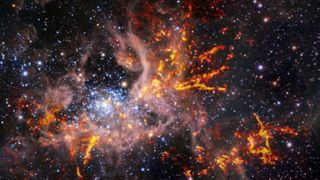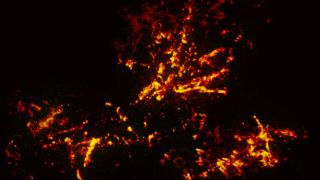Astronomers describe the star birth web of the cosmic Tarantula Nebula
The newly released image of 30 Doradus, also known as the Tarantula Nebula, reveals thin, spiderweb-like strands of gas that reveal a dramatic battle between gravity and stellar energy that could give astronomers an idea of how massive stars have shaped this star formation. regions and why they continue to be born in these molecular clouds.
This high-resolution image of the Tarantula Nebula, located 170,000 light-years from Earth, consists of data collected by the Atacama Large Millimeter/submillimeter Array (ALMA). Located in the Large Magellanic Cloud, a satellite galaxy of the Milky Way, the Tarantula Nebula is one of the brightest star-forming regions in our galaxy’s backyard. It’s also one of the most active in terms of giving birth to new stars, — some of which are more than 150 times the mass of the sun. At the heart of the Great Magellanic Cloud lies a stellar nursery that has spawned 800,000 stars, — half a million of which are hot, young, and massive stars.
This makes the nebula a prime target for researchers wishing to study star formation, and it has other unique properties that make it an attractive prospect for research studies.
“What makes 30 Doradus unique is that it is close enough for us to study in detail how stars form, but its properties are similar to those found in very distant galaxies when the Universe was young,” European Space Agency (ESA) scientist Guido De Marchi, a European Space Agency scientist and co-author of the paper describing the work, said in the statement: “Thanks to 30 Doradus, we can study how stars formed 10 billion years ago, when most stars were born.”
The battle to give birth to more massive stars
The researchers observed the “push and pull” created by the energy provided by the stellar population and its enormous gravity, with the former tearing the gas cloud into strand-like fragments thereby slowing star formation, and the latter trying to hold the gas cloud together to form. star.
“These fragments may be remnants of once larger clouds that have been destroyed by the massive energy released by young, massive stars, a process called feedback,” Tony Wong, a professor in the Department of Astronomy at the University of Illinois, said in a statement. at Urbana -Champaign said in a press release the European Southern Observatory (ESO) (opens in a new tab).
The findings also show that despite intense stellar feedback, gravity is still shaping the nebula – which lies 170,000 light-years from Earth and next to the Milky Way – and is driving the continued formation of massive stars.
This contradicts previous consensus on star-forming regions which suggested that thin strands of gas like those seen in the Tarantula Nebula should be too disturbed by this feedback to allow gravity to pull them together and form new stars.
“Our results imply that even in the presence of very strong feedback, gravity can exert a strong influence and lead to continued star formation,” continued Wong.
Observing the Tarantula Web clump by clump
Given its nature, it is not surprising that the Tarantula Nebula has been well studied. What makes this new study different is that while previous research has mostly focused on its center — the location of the densest gas and thus the fastest star formation — astronomers are aware that stars are also forming in other regions of the nebula the team gathered from high up. -resolution observation of the large region of the Tarantula Nebula rather than focusing on its heart. Taking a global approach to this nebula into account, they then dive into the clumps that reveal surprising patterns.
“We used to think of interstellar gas clouds as puffy or spherical structures, but it is becoming increasingly clear that they are like threads or filaments,” Wong said in a National Radio Astronomy Observatory (NRAO) press release. (opens in a new tab). “When we divided the cloud into clumps to measure density differences, we observed that the densest clumps were not randomly placed but highly organized on these filaments.”
Focusing on the light emitted by carbon monoxide gas allowed the researchers to map large, cold gas clouds in the Tarantula Nebula that collapsed to form baby stars. They also observed how these gas clouds changed as the young stars released large amounts of energy.
“We expect to find that the part of the cloud closest to the young massive star will show the clearest signs of gravity being overwhelmed by the feedback,” said Wong. (opens in a new tab) “We instead found that gravity was still important in this feedback-exposed region – at least for fairly dense parts of the cloud.”
Overlays data collected by ALMA and infrared images of the Tarantula Nebula showing bright stars and glowing hot gas from the Very Large Telescope and from the Infrared Survey Telescope for Astronomy (VIS) (opens in a new tab)TA) created a composite image showing the extent of the gas cloud and its net-like shape.
While the team’s findings provide an indication of how gravity affects star-forming regions, the research is still a work in progress. “Much remains to be done with this fantastic data set, and we are releasing it publicly to encourage other researchers to undertake new investigations,” Wong concluded.
Future studies will also focus on differences between the Milky Way and the Tarantula Nebula including the rate of star formation – while our galaxy continues to form stars, the Tarantula Nebula does so in “boom and bust” cycles.
Research on the Tarantula Nebula was presented at the 240th meeting of the American Astronomical Society (AAS) in Pasadena, California, on June 15. The findings are also presented in a paper in The Astrophysical Journal.
Follow us on Twitter @Spacedotcom (opens in a new tab) or on Facebook (opens in a new tab).
#Astronomers #describe #star #birth #web #cosmic #Tarantula #Nebula


Comments
Post a Comment